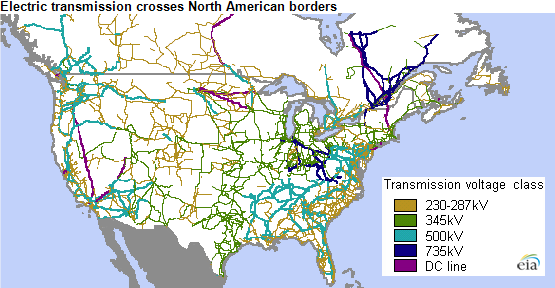Energy distribution technology
Energy distribution technology is any human-made system capable of transporting energy in the form of fuels like gasoline, or flows such as electricity. They are the backbone for the energy sector, as they allow energy to be transported globally in order to provide essentially any location with their energy needs, in effect driving the economy. When energy is produced in the form of electricity, gasoline, liquefied natural gas, or any other, it requires transportation to where it can be made useful. Distribution technologies make this task achievable, and in some cases are very efficient.

There are immense security systems in place in order to monitor and aid the safe functioning of these technologies, which can be read about here.
Systems
The transportation of different forms of energy ranges vastly depending on what it is. There are vast systems and methods in place to do so, with the largest and most important highlighted below:
- Electrical grid - when electricity is produced in power plants, it is done so in large quantities. All of this electric power must be distributed, sometimes over large areas, and the electrical grid accomplishes this. Consisting of both large high-voltage and smaller low-voltage power lines, along with numerous substations, the grid achieves efficient electrical transmission to its consumers. The efficiency of this system is very high, due to minimized power line losses, which can be read about here.
The technology used by the electrical grid is complex and interconnected, for a sense of this see Figure 2 below.

- Pipelines - oil and natural gas are often extracted outside of where the general population lives, therefore it must be transported to where it will be used. Pipelines play an important role in this process. In Canada alone there is an estimated 825 000 kilometers of lines that serve to transport natural gas, liquefied natural gas products, crude oil, and other refined petroleum products.[3] The enormous cost of constructing pipelines limits their use to locations where very large volumes of product are to be moved for an extended period of time, and the payback period for them is typically 15-20 years.[4] To see a map of all of these pipelines, click here.
- Trains, trucks, and ships - energy forms such as coal, liquefied natural gas, oil and gasoline can also be transported by other transportation means. Vehicles of all sorts can accomplish this, such as freight trains, LNG carriers and oil trucks.[4] Pipelines are often used for the distribution of large quantities of liquids and gases, however when the amount of petroleum products needed to ship cannot justify the cost of building a pipeline, these methods are preferred.
References
- ↑ This drawing was made by Xining Chen for this website in August 2015 and is used with her permission.
- ↑ EIA, Canada Week: Integrated electric grid improves reliability for United States, Canada [Online], Available: http://www.eia.gov/todayinenergy/detail.cfm?id=8930
- ↑ Natural Resources Canada. (June 8, 2015). Pipeline Safety [Online]. Available: http://www.nrcan.gc.ca/sites/www.nrcan.gc.ca/files/energy/files/pdf/14-0277-%20PS_pipelines_across_canada_e.pdf
- ↑ 4.0 4.1 Natural Resources Canada. (August 10, 2015). Petroleum Products Distribution Networks' [Online], Available: https://www.nrcan.gc.ca/energy/infrastructure/5897

